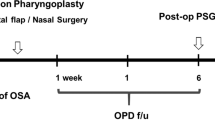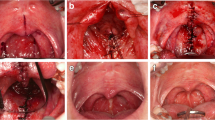Abstract
Purpose
Pharyngeal flap surgery used for treatment of velopharyngeal insufficiency (VPI) may be followed by obstructive sleep apnea (OSA) especially if the patient has developed adenoid hypertrophy. However, adenoidectomy may adversely affect speech in these patients. The aim of this study was to assess the effectiveness of transnasal endoscopic power-assisted adenoidectomy in relieving OSA in patients with adenoid hypertrophy who underwent pharyngeal flap surgery, and the impact of the procedure on their speech.
Methods
Transnasal endoscopic power-assisted adenoidectomy for nine children presenting with adenoid hypertrophy was performed. The patients had previously undergone pharyngeal flap surgery for treatment of VPI. Flexible nasopharyngoscopy was used in the diagnosis of adenoid hypertrophy. Pre- and postoperative polysomnography with measurement of apnea–hypopnea index (AHI) was done. Additionally, auditory perceptual assessment of speech (APA) and nasalance scores was measured pre- and postoperatively.
Results
All patients were shown to have OSA by polysomnography, and a larger adenoid size was significantly associated with a higher AHI. We achieved a significant improvement in AHI after adenoidectomy. However, six patients still demonstrated OSA, albeit with a reduced severity. Speech was not adversely affected postoperatively as the APA and nasalance scores showed non-significant changes.
Conclusion
Adenoid hypertrophy may be encountered in children who undergo pharyngeal flap surgery, which may cause OSA. Transnasal endoscopic power-assisted adenoidectomy is a safe and effective method for treatment of OSA in those patients without prejudicing the pharyngeal flap, and it has no adverse effect on speech.

Similar content being viewed by others
References
Ysunza A, Pamplona MC, Molina F et al (2004) Surgery for speech in cleft palate patients. Int J Pediatr Otorhinolaryngol 68:1499–1505
Bicknell S, McFadden LR, Curran JB (2002) Frequency of pharyngoplasty after primary repair of cleft palate. J Can Dent Assoc 68:688–692
Abdel-Aziz M, Hussien A, Kamel A, Azooz K, Fawaz M (2018) The Impact of velopharyngeal surgery on the polysomnographic parameters after cleft palate repair. J Craniofac Surg 29:717–719
Katzel EB, Shakir S, Naran S et al (2016) Speech outcomes after clinically indicated posterior pharyngeal flap takedown. Ann Plast Surg 77:420–424
Campos LD, Trindade-Suedam IK, Sampaio-Teixeira AC et al (2016) Obstructive sleep apnea following pharyngeal flap surgery for velopharyngeal insufficiency: a prospective polysomnographic and aerodynamic study in middle-aged adults. Cleft Palate Craniofac J 53:e53–59
Kotagal S, Chopra A (2012) Pediatric sleep-wake disorders. Neurol Clin 30:1193–1212
Suri JC, Sen MK, Venkatachalam VP et al (2015) Outcome of adenotonsillectomy for children with sleep apnea. Sleep Med 16:1181–1186
Abdel-Aziz M, Azooz K, Naguib N, Reda R, Kamel A (2017) The effect of adenotonsillectomy on obstructive sleep apnea in children with Down syndrome. Acta Otolaryngol 137:981–985
Marcus CL, Brooks LJ, Draper KA et al (2012) Diagnosis and management of childhood obstructive sleep apnea syndrome. Pediatrics 130:576–584
Muzumdar H, Arens R (2008) Diagnostic issues in pediatric obstructive sleep apnea. Proc Am Thorac Soc 15:263–273
Abdel-Aziz M (2012) The effectiveness of tonsillectomy and partial adenoidectomy on obstructive sleep apnea in cleft palate patients. Laryngoscope 122:2563–2567
Brodsky L (1989) Modern assessment of tonsils and adenoids. Pediatr Clin N Am 36:1551–1569
Cassano P, Gelardi M, Cassano M, Fiorella ML, Fiorella R (2013) Adenoid tissue rhinopharyngeal obstruction grading based on fiberendoscopic findings: a novel approach to therapeutic management. Int J Pediatr Otorhinolaryngol 67:1303–1309
Scott B, Johnson RF, Mitchell RB (2016) Obstructive sleep apnea: differences between normal-weight, overweight, obese, and morbidly obese children. Otolaryngol Head Neck Surg 154:936–943
Chegar BE, Shprintzen RJ, Curtis MS, Tatum SA (2007) Pharyngeal flap and obstructive apnea: maximizing speech outcome while limiting complications. Arch Facial Plast Surg 9:252–259
Hubbard BA, Rice GB, Muzaffar AR (2010) Adenoid involvement in velopharyngeal closure in children with cleft palate. Can J Plast Surg 18:135–138
Finkelstein Y, Wexler DB, Nachmani A, Ophir D (2002) Endoscopic partial adenoidectomy for children with submucous cleft palate. Cleft Palate Craniofac J 39:479–486
Askar SM, Quriba AS (2014) Powered instrumentation for transnasal endoscopic partial adenoidectomy in children with submucosal cleft palate. Int J Pediatr Otorhinolaryngol 78:317–322
Acknowledgements
Very thankful to the staff members of the Phoniatric unit of our institute for their efforts in diagnosis and referral of the patients.
Funding
Self-funded. There are no financial disclosures.
Author information
Authors and Affiliations
Corresponding author
Ethics declarations
Conflict of interest
There are no conflicts of interest.
Ethical approval
The study protocol was approved by the Research Ethics Committee of the Faculty of Medicine of Cairo University (N-64-2011).
Additional information
Publisher's Note
Springer Nature remains neutral with regard to jurisdictional claims in published maps and institutional affiliations.
This case series study was conducted in the Departments of Otolaryngology of Cairo University, Aswan University, and Fayoum University, Egypt in the period from March 2011 to February 2018.
Electronic supplementary material
Below is the link to the electronic supplementary material.
Rights and permissions
About this article
Cite this article
Abdel-Aziz, M., El-Fouly, M., Elmagd, E.A.A. et al. Adenoid hypertrophy causing obstructive sleep apnea in children after pharyngeal flap surgery. Eur Arch Otorhinolaryngol 276, 3413–3417 (2019). https://doi.org/10.1007/s00405-019-05633-z
Received:
Accepted:
Published:
Issue Date:
DOI: https://doi.org/10.1007/s00405-019-05633-z




